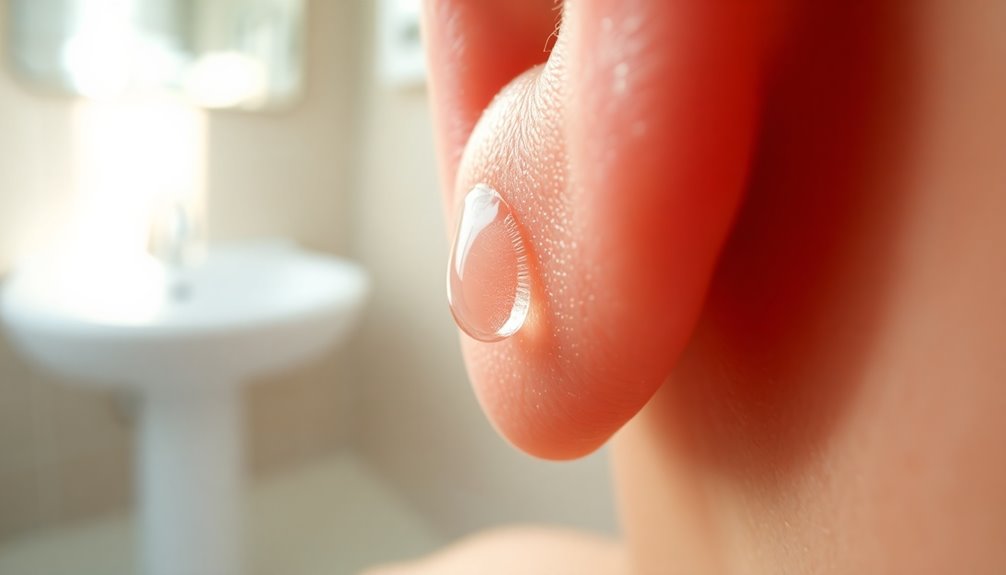When your water breaks, the amniotic fluid usually appears clear or pale yellow and is often odorless. Sometimes, you might catch a slight sweet smell, but nothing strong or unpleasant. If you notice a foul odor, it could signal an infection or other concerns, so it's important to contact your healthcare provider right away. Remember, this moment marks the exciting start of your labor journey! The nature of the fluid can tell you a lot about your baby's well-being. Curious about what to do next? You'll want to know tips on monitoring fluid changes and ensuring safety!
Key Takeaways
- Amniotic fluid is typically clear or pale yellow and usually odorless, with a slightly sweet scent detected by some individuals.
- Foul-smelling fluid may indicate an infection or the presence of meconium, necessitating immediate medical attention.
- Meconium-stained fluid can be greenish or brownish, signaling potential fetal distress and requiring careful monitoring.
- Continuous leaking after water breaks suggests amniotic fluid, not urine, so it's important to differentiate between the two.
- Awareness of fluid characteristics is essential for ensuring the health and safety of both mother and baby during labor.
Introduction

When your water breaks, it can be a moment of excitement and anxiety, and understanding what to expect is crucial. You might feel a rush of emotions as you realize that this is the start of your journey into parenthood.
Typically, amniotic fluid is clear or light yellow and odorless, which helps you distinguish it from urine. If you notice any changes in fluid characteristics, like a greenish or brownish color, it can indicate the presence of meconium. This might suggest fetal distress, so don't hesitate to reach out to your healthcare provider.
Maintaining a balanced diet and staying hydrated can also play a role in your overall health during pregnancy, as effective strategies for weight loss can support your well-being.
It's important to monitor everything closely. While amniotic fluid generally lacks a strong odor, some women might detect a slightly sweet scent. However, if the fluid smells foul, it could signal an infection, and you should seek medical attention right away.
Remember, knowing what to look for can make a difference in ensuring both your safety and your baby's. Stay calm, and trust your instincts as you navigate this incredible experience.
Description of the Smell

At the moment your water breaks, you might notice that amniotic fluid is typically clear, pale yellow, and odorless. This is one of the things that sets it apart from urine or other vaginal discharges. While most people find it doesn't have much of a smell, some might detect a slightly sweet scent. It's usually not strong or unpleasant, which can be a relief during such an exciting time!
Additionally, maintaining a clean and healthy environment can contribute to overall well-being, which is crucial during pregnancy, as improved air quality can help reduce allergens and support respiratory health air quality benefits.
However, if you notice any foul-smelling amniotic fluid, that could be a sign of something more serious. It might indicate an infection or the presence of meconium, which is the first stool your baby makes.
If you do encounter a strong or unpleasant odor, it's important to contact your healthcare provider right away for a medical evaluation.
Source and Composition

Amniotic fluid plays a vital role during pregnancy, acting as a protective cushion for the developing fetus. When your water breaks, the amniotic fluid typically appears clear or pale yellow and is usually odorless. This fluid creates a safe and comforting environment for your baby, similar to how grain-free options cater to dogs with specific dietary needs.
You might notice a slight sweet scent, but if you detect a strong or foul odor, it's essential to consult your healthcare provider.
Sometimes, the fluid can be meconium-stained, which may look greenish or brownish. This can signal fetal distress, and it's important to get it checked out right away. Distinguishing amniotic fluid from urine is crucial, as urine tends to be darker yellow and has a more noticeable smell.
If you're experiencing continuous leaking fluid after your water breaks, it's likely amniotic fluid. Unlike urine, which can be emptied, amniotic fluid will keep coming.
Typical Scenarios or Environments

During labor, the environment can greatly influence your experience after your water breaks. In a sterile hospital setting, the amniotic fluid you release is usually clear or light yellow and odorless. This helps you differentiate it from urine, which has a darker color and a strong smell.
Sometimes, though, amniotic fluid might've a slightly sweet scent, but if you notice a foul smell, it could indicate an infection, leading to immediate medical evaluation.
You should also pay attention to the color and consistency of the fluid. If you see greenish or brownish fluid, it may contain meconium, which can signal fetal distress. This is a crucial moment, and quick action is essential.
Whether at home or in a hospital, being aware of your surroundings can help you understand what's happening. Remember, the sterile environment of a hospital typically keeps the area free from strong odors, making it easier for you to identify any changes in the smell of your amniotic fluid.
Keeping these factors in mind can help you feel more prepared and informed during this important time.
Emotional or Cultural Associations

Water breaking often marks a significant emotional milestone in your pregnancy journey, signaling that childbirth is imminent. It's a moment filled with anticipation, excitement, and perhaps a little anxiety. This event symbolizes your transition from pregnancy to motherhood, making it a celebrated rite of passage in many cultural traditions.
In various cultures, water breaking carries emotional significance, highlighting the importance of being prepared for labor. Families often engage in customs or rituals that honor this crucial moment, reflecting their hopes and dreams for the new life to come.
You might find that stories about water breaking in media and literature reinforce these narratives, offering a glimpse into the emotional experiences of expectant parents.
Additionally, spiritual beliefs often surround this phenomenon. Some families seek blessings or guidance, believing that the moment of water breaking can invite protection for both you and your baby.
Embracing these cultural traditions can help you feel more connected to the journey of childbirth, making the experience richer and more meaningful.
Health or Safety Considerations

As you approach the moment of labor, understanding the health and safety considerations surrounding water breaking becomes important.
Typically, when your water breaks, the amniotic fluid is odorless or may have a slightly sweet scent. This sets it apart from urine, which has a strong, pungent odor. If you notice a foul smell, that could signal an infection, so getting medical attention right away is crucial.
The color of the amniotic fluid also matters. It's usually clear or light yellow, but if it appears greenish or brownish, that might mean meconium is present. This can indicate potential fetal distress, so it's essential to keep an eye on any changes.
Monitoring the characteristics of the fluid after your water breaks is key; continuous leaking suggests the amniotic sac has ruptured, and you should reach out to your healthcare providers for further evaluation.
Being aware of these differences in smell and appearance can help you make informed decisions about seeking medical care.
Final Thoughts

In the journey toward labor, understanding the signs and characteristics of water breaking is crucial for your health and your baby's well-being.
When your water breaks, the amniotic fluid is typically clear and odorless, which helps distinguish it from urine. Some might notice a slightly sweet scent, but no strong smells should be present. If you detect a foul odor, it could signal an infection, and you should contact your healthcare provider right away.
Another important aspect to watch for is meconium-stained fluid. This fluid may appear greenish or brownish and can indicate fetal distress, meaning your baby's health may be at risk. Monitoring the characteristics of the fluid helps ensure both you and your baby are safe.
Knowing what to expect when your water breaks can make a big difference. Stay aware and keep track of any changes. If something seems off, don't hesitate to reach out for help.
Frequently Asked Questions
Does Water Breaking Have a Smell?
Water breaking can have a faint odor, but it's often odorless or slightly sweet. If you notice a strong or foul smell, it's crucial to seek medical attention as it may indicate an infection.
How Do I Know if My Water Broke or Is Leaking?
To know if your water's broken or leaking, pay attention to fluid consistency and amount. If you notice continuous leakage or a sudden gush, contact your healthcare provider for guidance and assessment.
How Can I Tell if I'm Leaking Amniotic Fluid?
To tell if you're leaking amniotic fluid, pay attention to fluid color and odor. If it's clear or light yellow and continuous when you stand, it's likely amniotic fluid. Contact your healthcare provider for confirmation.
What Does an Amniotic Fluid Leak Smell Like?
An amniotic fluid leak usually doesn't have a strong smell. It's often clear or light yellow, mildly sweet, and distinct from urine. If you notice a foul odor, contact your healthcare provider immediately.









